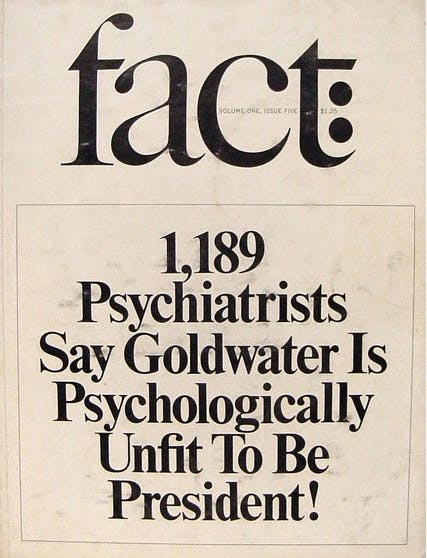Here's What You Need To Know About Nancy Pelosi, Donald Trump, And The 25th Amendment
As President Trump was hospitalized for treatment for COVID-19 last week, Nancy Pelosi rushed through a bill designed to help Congress remove a President via the 25th Amendment.

Most Americans are probably familiar with the process of impeachment, in which Congress can accuse a President of “high crimes and misdemeanors.” Congress can then attempt to remove the President from office with a two-thirds vote of the members of both houses. In U.S. history, only three presidents have been impeached (Andrew Johnson, Bill Clinton, and Donald Trump), but none were successfully removed from office.
But there is another, less well-known way in which Congress has the authority to remove the President. Most Americans probably aren’t familiar with it, since it’s never truly been put to use. In theory, the 25th Amendment provides guidelines for replacing a President who is still alive but medically or mentally unable to perform his duties.
The 25th Amendment provides guidelines for replacing a President who is still alive but medically or mentally unable to perform his duties.
Donald Trump's recent diagnosis of COVID-19 has prompted politicians to call his physical wellbeing into question. Nancy Pelosi says she needs the legislation to make it easier for Congress to remove a President if he is medically unfit. So let’s take a step back and look at just what the Amendment is intended to do and why the Democrats want to use it against President Trump.
A Brief History of the 25th Amendment
When the Constitution was first written, it provided instructions only for the replacement of a president if he died in office. But over the next two centuries, especially as medical science improved radically, it became clear that a situation in which a President could be technically alive but unable to perform his duties was an increasing risk. For example, a President could suffer a stroke or fall into a coma. While technically still alive, he would be unable to act as President and therefore would need to be replaced peacefully for the safety of the Union.
President Kennedy’s assassination in 1963 solidified fears that had already been stirring in Congress. In January 1965, a resolution was proposed and passed in both houses of Congress that would add a new amendment to the Constitution, designed to deal with these very issues. The proposal “specified the process by which a president could be declared ‘unable to discharge the powers and duties of his office,’ thereby making the vice president an acting president, and how the president could regain the powers of his office. Also, their proposal provided a way to fill a vacancy in the office of vice president before the next presidential election.”
The proposal specified how a president could be declared unable to discharge his office, making the vice president acting president.
The 25th Amendment was used in 1985, for example, when Ronald Reagan had to go under anesthesia for a medical procedure. On July 13, Reagan signed a letter “before being placed under general anesthesia for a colectomy, and Vice President George H. W. Bush was acting president from 11:28 a.m. until 7:22 p.m., when Reagan transmitted a followup letter declaring himself able to resume his duties.”
Clearly, the Amendment was put in place with the explicit intention of replacing a President who is completely incapacitated and unable to serve his office. It’s not a replacement or even an equivalent of impeachment, and should never be used as a way to forcibly remove a President for political reasons.
Trump, the 25th Amendment, and the Goldwater Rule
This isn’t the first time the Democrats have used threats of the 25th Amendment against a President or presidential candidate, and it’s not even the first time they’ve done so against President Trump. Even during his candidacy, the Democrats and media portrayed him as unhinged and mentally unstable. Once he was in office, a flurry of articles and speeches were launched, outlining how Donald Trump might be mentally unfit for the office of President, and that Congress would have a “duty” under the 25th Amendment to remove him from the office.
Articles outlining how Trump might be mentally unfit to be President violated a cardinal rule of psychology.
Such articles, especially ones written by psychologists claiming they had a “responsibility to the public” to diagnose and warn against a Trump presidency, violated a cardinal rule of psychology established in the ‘60s. The Goldwater Rule, as it’s now known, was coined after another Republican candidate, billionaire Barry Goldwater, lost his bid for the presidency after a bit of dirty maneuvering by a hard-left magazine.
A month before the 1964 election, a fringe left-wing publication, Fact magazine, erroneously claimed on its front cover, “1,189 Psychiatrists Say Goldwater Is Psychologically Unfit To Be President!” Ads for the magazine ran in The New York Times and several other major papers.

Ginzburg purposefully misrepresented the numbers to make a better headline.
The magazine’s publisher, Ralph Ginzburg, came up with the number from a survey in which he asked 12,356 psychiatrists one question: “Do you believe Barry Goldwater is psychologically fit to serve as President of the United States?”
Ginzburg got 2,417 responses, in which 657 thought he was fit, and 571 wouldn’t take a position. Two-thirds of the doctors were willing to have their names printed alongside their responses, which called Goldwater “‘emotionally unstable,’ ‘immature,’ ‘cowardly,’ ‘grossly psychotic,’ ‘paranoid,’ ‘mass murderer,’ ‘amoral and immoral,’ ‘chronic schizophrenic,’ and ‘dangerous lunatic.’ One psychiatrist even felt that a proposed Goldwater visit to Hitler’s Berchtesgaden ‘is enough to convince me of his strong identification with the authoritarianism of Hitler, if not identification with Hitler himself’.”
These quotes could have been pulled from any number of articles written about our current President. But for Goldwater, the hit piece was enough to sink his campaign permanently. The Fact magazine issue exploded, and major publications quoted and pushed its phony conclusions.
Eventually, the magazine was sued (and forced to pay a crushing fine) for defamation. The APA, recognizing the role of politically motivated psychologists in the fiasco, introduced “The Goldwater Rule” against speculative diagnosis. In short, “it is unethical for psychiatrists to give a professional opinion about public figures whom they have not examined in person, and from whom they have not obtained consent to discuss their mental health in public statements.”
It’s unethical for psychiatrists to give a professional opinion about public figures whom they have not examined in person.
Apparently, psychologists didn’t learn their lesson thoroughly enough in 1964. Throughout Trump’s presidency, articles have continued to spring up: "'Sociopathy': Psychiatrist says Trump's behavior 'meets criteria for a locked psychiatric facility'" or “The silencing of psychiatry: is the Goldwater rule doing more harm than good ahead of the US 2020 election?”
The Politicization of the 25th Amendment
Since President Trump was sworn into his office in 2017, the Democrats have made three concerted efforts to remove him from office. The first was an attempt to have him declared mentally unfit and then forcibly remove him from office. It was no more than an empty threat, since the Democrats lacked the two-thirds majority in both houses of Congress necessary for such an action. After they failed to take the Senate in 2018, they still brought forth an impeachment movement, which was also doomed to fail as it would never have passed the Senate. (The House may impeach the President, but both houses must pass a resolution to actually remove the President from office.)
Now, we’re witnessing their third attempt. Amid news that President Trump was hospitalized for COVID-19, Nancy Pelosi rushed to submit legislation that would allow Congress to remove a President more easily from office via the 25th Amendment. The issue is, her party has no hope of the legislation passing, and she still doesn’t have the two-thirds majority necessary under the Amendment as it’s currently written.
Which leaves the burning question: If Nancy Pelosi knows that she can’t possibly use the 25th Amendment to remove President Trump, what’s the point of bringing it up at all? There are two equally likely options. Both are worrying.
1. To call Donald Trump's capacity into question before the election day.
With mere weeks until the election, this seems like a likely move. A lot of people are mad that the President seems to have recovered rather quickly and effortlessly from COVID. In fact, he's already headed back to the campaign trail after testing negative twice. So, while the legislation was submitted during Donald Trump's hospitalization, it seems to be a bit of a moot point now. Which leads us to our second hypothesis.
2. The Democrats will use the 25th Amendment to remove Biden from office, opening the door to a Kamala Harris presidency.
This is another and more concerning possibility. Joe Biden's mental capacity has been questioned throughout his run for the presidency. From disjointed and confusing speeches to losing his train of thought mid-question, it's no surprise that many suspect Joe Biden may be in the early stages of dementia. Are the Democrats letting these rumors fester as a precursor to their true plan? If they can lower the threshold for utilizing the 25th Amendment, their real plan may be to remove Biden once he's in office and replace him with his Vice President, Kamala Harris.
There are several reasons Democrats would prefer Harris to Biden. She's younger, female, non-white, and much more radical than Biden. Being President is exhausting, and perhaps even the Democrats recognize that the office might just be too much for the 77-year-old Biden. It would behoove the Democrats to have an energetic figure like Harris, rather than the feeble Biden, in the Oval Office.
Closing Thoughts
The uses of the 25th Amendment are clear, as well as its precedent for use. It should not be used except under the most strict of circumstances, and these efforts to pave the way for more easily removing a President should have Democrats and Republicans alike worried. Congress doesn't have the authority to usurp the decision of voters for their choice of President, whether that President is Donald Trump or Joe Biden.